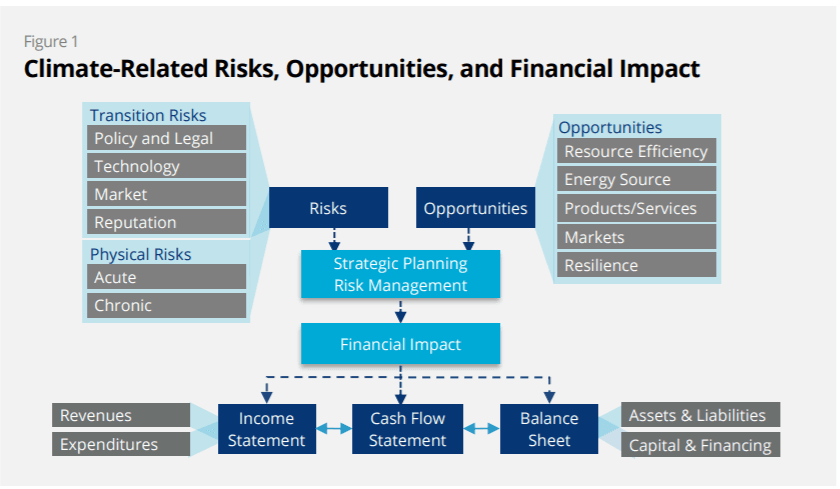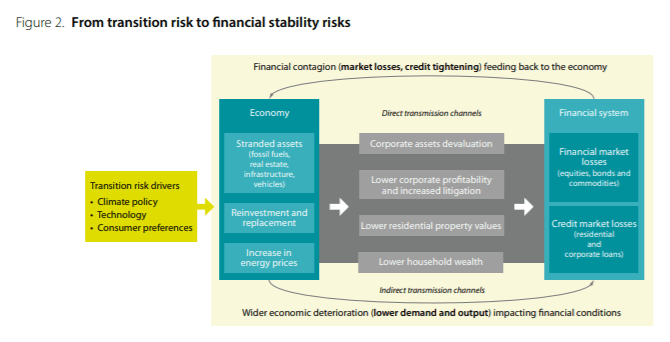Climate Change as a Financial and Systemic Risk
Nearly 200 governments around the world have committed to pursue efforts to limit global temperature rise to 1.5°C above pre-industrial levels. This goal was first set out in the landmark 2015 Paris Agreement, signed by 196 countries at the 21st Conference of Parties (COP 21) to the United Nations Framework Convention on Climate Change (UNFCCC), and has been upheld and reaffirmed at subsequent COPs since then, particularly since the finalisation of the ‘Paris Rulebook’, the rules and procedures for implementing the Paris Agreement’s goals, at COP 26 in Glasgow in 2021.
However, in June 2024, the World Meteorological Organisation (WMO) predicted an 80% likelihood that annual average global temperatures will temporarily exceed the 1.5°C level for at least one of the next five years. Similar warnings have been issued by the Intergovernmental Panel on Climate Change (IPCC), an intergovernmental scientific body of the UN. The IPCC published its Sixth Assessment Report (AR6) in three tranches between August 2021 and April 2022, with its AR6 Synthesis Report following in March 2023. These reports address the physical science behind human-induced climate change and its impacts, the vulnerabilities of the global system to climate change and the required adaptations, and the actions needed to mitigate its worst impacts, including limiting global temperature rise to 1.5°C. AR6 served as a strong warning for the international community that we are not on track to meet the Paris Agreement’s goals. The AR6 Synthesis Report confirmed that human activities, principally through emissions of GHGs, have “unequivocally caused global warming, with global surface temperature reaching 1.1°C above 1850-1900 in 2011-2020.” Floods (such as those faced in Pakistan in 2022), freezes (such as the Texas winter freeze in February 2021), fires (such as those in Australia in 2023) and heatwaves (such as those in April 2024 across the Philippines, Thailand, Bangladesh and India) have caused disruption to supply chains. In 2023, 142 natural catastrophes led to USD 108 billion in insured losses, and analysis has found that heightened climate-related physical risks have led to increased exposure for insurers.
As the effects of climate change and the actions needed to address them increasingly materialise, the links between climate change and financial risk are becoming increasingly evident and inextricable. Our understanding of climate change has evolved from a purely ‘ethical issue’ or ‘environmental externality’ to an issue that poses foreseeable financial risks and opportunities for companies across short, medium and long-term horizons. In a 2024 survey of top executives with large companies worldwide, 70% of respondents said rising emissions and global temperatures will have a “high or very high” impact on operations, with 45% reporting that they are changing their business model to reduce emissions and prepare for a low-carbon economy. Indeed, the World Economic Forum’s 2024 report on global risks ranks extreme weather events and biodiversity loss and ecosystem collapse – along with impacts which may become more likely as a result of climate change, such as large-scale involuntary migration, and critical change to earth systems – within the top 10 risks by severity over the next 10 years. The Global Tipping Points report published in 2023 concluded at least five major Earth system tipping points are already at risk of being triggered, including the collapse of major ice sheets such as those in Greenland and warm-water coral reefs. Where tipping points are reached in one system, they can spark rapid and irreversible transformation.
The scale and speed of climate change risks and opportunities in the transition to a zero-carbon economy received heightened attention in May 2021 with the release of the International Energy Agency (IEA)’s first-ever attempt to model a feasible pathway to net zero GHG emissions by 2050 (NZE2050), and the implications of the NZE2050 scenario for companies in the industry sectors facing either accelerated decline or rapid growth are momentous. The NZE2050 scenario has formed the basis for a number of shareholder resolutions, court cases, and engagements with government bodies.
However, the UNFCCC has consistently found that the international community is falling far short of the action required to limit temperature rise to 1.5°C and meet the goals of the Paris Agreement. The latest Emissions Gap Report from the UN Environment Programme (UNEP) reports that current pledges under the Paris Agreement - the credibility of even these existing policies is uncertain - put the world on track for a 2.5-2.9°C temperature rise above pre-industrial levels this century. Indeed, “wide-ranging, large-scale, rapid and systemic transformation is now essential to achieve the temperature goal of the Paris Agreement”.
Companies operating in industries facing structural decline can expect heightened pressure from investors to stress-test their businesses against new data, and to demonstrate their ability to remain resilient in the face of uncertainty regarding the pace of change, failing which access to capital will continue to suffer headwinds. For directors, this adds yet another factor they must consider in the boardroom when modelling risk and strategic options.
According to the 2017 recommendations of the Task Force on Climate-related Financial Disclosures (TCFD), climate change is one of the most significant and complex risks facing organisations. The TCFD recommendations have attracted the support of nearly 5,000 organisations, which reflects the growing consensus among the business, financial and regulatory communities of the financial and systemic risks presented by climate change and of the necessity of embedding climate change in financial risk management, disclosure and supervisory practices.

The Bank of England Prudential Regulation Authority has explained that these climate-related financial risks have distinctive elements and the unique characteristics of climate risks require a more forward-looking approach than used for many other risks to ensure their capture by capital frameworks. The risks are far-reaching in breadth and magnitude across the economy, involve uncertain and extended time horizons, are foreseeable, and – crucially – the magnitude of future financial risks depends in large part on decisions taken today.
Moving beyond company-specific financial risks, climate change is now recognised as a systemic risk. This was made clear in 2019 by The Network of Central Banks and Supervisors for Greening the Financial System (NGFS), a global coalition of over 110 central banks and supervisors, in its first comprehensive report, A Call to Action, which stated:
Climate-related risks are a source of financial risk. It is therefore within the mandates of central banks and supervisors to ensure the financial system is resilient to these risks.
According to the Banque de France and the Bank for International Settlements, known as the 'central bank of central banks', the radical uncertainty of climate change and society's responses to it mean that climate change poses 'green swan' systemic risks that could lead to a financial crisis. Stress tests which cover climate-related risks are planned or have already been conducted by central banks around the world, including the European Central Bank, the Reserve Bank of New Zealand, De Nederlandsche Bank and the Bank of England, which published the findings of its Climate Biennial Exploratory Scenario in May 2022.

Figure 2: Climate-related systemic risks arising from transition risks.
(Source: NGFS Guide for Supervisors: Integrating climate-related and environmental risks into prudential supervision (2020) p. 13)
As a now widely-recognised financial and systemic risk, as well as a factor that is integral to value creation, climate change squarely engages directors’ duties and disclosure obligations. In line with these developments, financial regulators have increasingly insisted on effective climate risk disclosure and governance.
So, too, investors have set normative expectations of director conduct. A coalition of financial institutions, the Glasgow Financial Alliance for Net Zero (GFANZ), has published guidance for its members on expectations for real-economy transition plans, portfolio alignment with achieving a net-zero by 2050 goal, and managing a phaseout of high-emission assets. The Institutional Investors Group on Climate Change (IIGCC), a membership body with over EUR 65tn asset under management (AUM), has published policies and guidance for members on engaging with investee companies on climate matters; and the Net Zero Asset Managers initiative, a group of asset managers with more than USD 57tn AUM has published its initial targets for managing its assets in line with achieving net-zero by 2050 or sooner.
Investors are also becoming increasingly vocal in communicating these expectations in their voting and stewardship activities. In 2021, shareholders at large oil and gas companies brought resolutions requesting that these companies set and report on climate targets, and notably, investors voted to replace three of ExxonMobil’s board members with alternative candidates with experience in the transition of oil and gas companies. In 2022, over 215 resolutions relating to climate change were filed by shareholders. This increased to 257 environmental and social shareholder filed resolutions in 2023. Climate Action 100+ expects companies to align their political engagement with climate goals, and for the 2024 proxy season has called on companies to report on climate lobbying practices. More than 700 investors – responsible for around USD 68 trillion in AUM – are represented in Climate Action 100+. In addition, of the two proxy advisory firms controlling 97% of voting advice to institutional investors, ISS will generally recommend to vote against directors in cases where the company is not taking the minimum steps needed to be aligned with a Net Zero by 2050 trajectory, and Glass Lewis will vote against relevant directors when a company has not provided disclosures of the environmental and social risks facing the company and what steps the company is taking to mitigate those risks.
Investors, regulators and governments are also increasingly asking companies to produce net zero transition plans, setting out items including the company’s ambition, the activities covered by the plan, targets and dates for achieving targets, proposed use of offsets, financial impacts, and plans to engage through their value chain. First-mover companies have already begun to produce climate transition plans, and investor groups including GFANZ have published guidance on what they expect investee companies to include in their business plans. The UK Government established the Transition Plan Taskforce (TPT) which has developed internationally applicable guidance and standards for transition plans. Climate transition plans are required in the UK for certain companies but are expected to become mandatory in the future. In the EU, the Corporate Sustainability Due Diligence Directive will require companies to adopt a transition plan to ensure that the business model and strategy of the company are compatible with the goal of limiting global warming to 1.5°C.
Investors are also encouraging companies to increase the ambition of their net zero targets, which is leading towards increased standardisation between companies’ targets. Race to Zero, a global campaign with support from businesses, cities, regions, and investors, has published criteria for its members, which include a net-zero pledge, covering scope 1, 2 and material scope 3 emissions, made from the top level of the company.
Sustainability standards requiring disclosure of metrics and targets are steadily converging towards similar requirements. In June 2023, the International Sustainability Standards Board (ISSB) published its finalised sustainability reporting standards, which are aimed to bring about a harmonised framework for sustainability disclosures, including those relating to climate. The ISSB climate standard (IFRS S1 and S2), if adopted in domestic laws, will require companies to disclose physical and transition climate risks facing their business model, their scope 1, 2 and 3 emissions, their resilience to climate impacts using different scenarios, and information about their transition plans.
